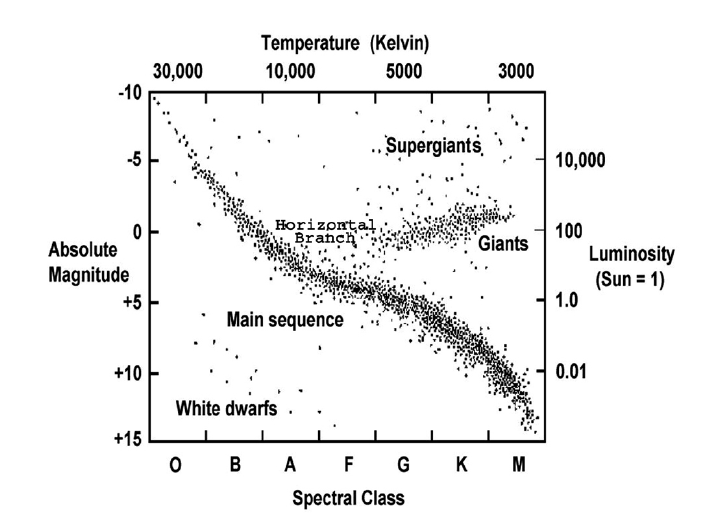
Red hypergiants are also the biggest stars, while red dwarfs, having a fully convective structure, exhaust their hydrogen fuel very slowly compared to other stars. Red dwarfs, smaller than the sun, temperatures 3,000-4,000 degrees Kelvin and more common than red giants, which are old 3,100 degree Celsius stars in the last stages of their life. Type M stars are the most common type of star in the universe. Molecules begin to appear in weak spectral lines. Type K stars are orange to orange-red stars with temperatures between 4,100-5,100 degrees. Ionized calcium and iron are present in their spectra. Type G stars are yellow stars with temperatures between 5,700-6,400 degrees Kelvin. They have temperatures of ~7,500 degrees Celsius or Kelvin. Type F stars are yellow stars that contain dominant calcium lines in their spectra. Temperatures ~10,000 degrees Celsius or Kelvin. They are some of the brightest stars in the sky. Type A stars are white stars which have the strongest hydrogen lines. B type stars with Balmer lines in their spectra are part of the Be stars subtype. They are high in helium spectral lines and luminosity (brightness compared to the Sun), with moderately strong hydrogen lines. Type B stars are blue stars which have temperatures of ~25,000 degrees (Celsius or Kelvin). They are also very massive but, at the same time, very rare. They are blue in color and can be more than 6.5 times bigger than the Sun. Type O stars are stars with temperatures of ~35,000 degrees Celsius or Kelvin. This is a natural consequence of the evolution of human optical senses: the response curve that maximizes the overall efficiency against solar illumination will by definition perceive the Sun as white, though there is some subjective variation between observers.

The Sun itself is white, though it is sometimes called a yellow star. The apparent color descriptions are what the observer would see if trying to describe the stars under a dark sky without aid to the eye, or with binoculars. The conventional color descriptions are traditional in astronomy, and represent colors relative to the mean color of an A-class star which is considered to be white. It is as important to astronomy as the periodic table is to chemistry.Ĭonventional and apparent colors It relates the absolute magnitude and the surface temperature. The Hertzsprung-Russell diagram is more often used in astronomy. The Hertzsprung-Russell diagram relates stellar classification with absolute magnitude, luminosity, and surface temperature. For example, A0 denotes the hottest stars in the A class and A9 denotes the coolest ones. The spectral classes O through M are subdivided by Arabic numerals (0–9). The mass, radius, and luminosity listed for each class are appropriate only for stars on the main-sequence portion of their lives and so are not appropriate for red giants. However, the actual apparent colors the eye sees are lighter than the conventional color descriptions. Note: The conventional color description describe only the peak of the stellar spectrum. Physically, the classes indicate the temperature of the star's atmosphere and are normally listed from hottest to coldest, as is done in the following table: Stars vary in surface temperature from about 2,000 to 40,000 kelvin. The Harvard classification system is a one-dimensional classification scheme. Harvard spectral classification Classification of stars from O to M. The closest star to the Earth, the Sun, is a class G star. There are also "failed" stars, called brown dwarfs, have spectral types of L, T, and Y.
Main sequence spectral class full#
The full system contains other types that are hard to find: W, R, N, and S. M stars are the coldest stars and O stars are the hottest. The seven main types are M, K, G, F, A, B and O. In general, a star's temperature determines its color, from red to blue-white. Stars are also grouped into spectral types or classes by color. Star temperature can be measured by looking at its spectrum, the type of light that the star shines.

In astronomy, stellar classification is a way of grouping stars by temperature. M stars are the coldest and O stars are the hottest in stellar classification. Please help improve the page to make it understandable for everybody, without removing the technical details. This article uses too much jargon, which needs explaining or simplifying.


 0 kommentar(er)
0 kommentar(er)
